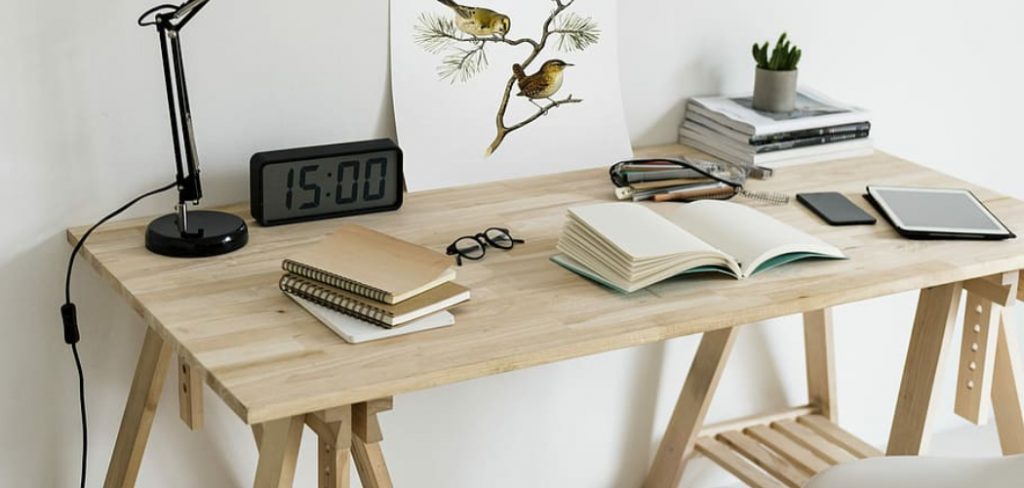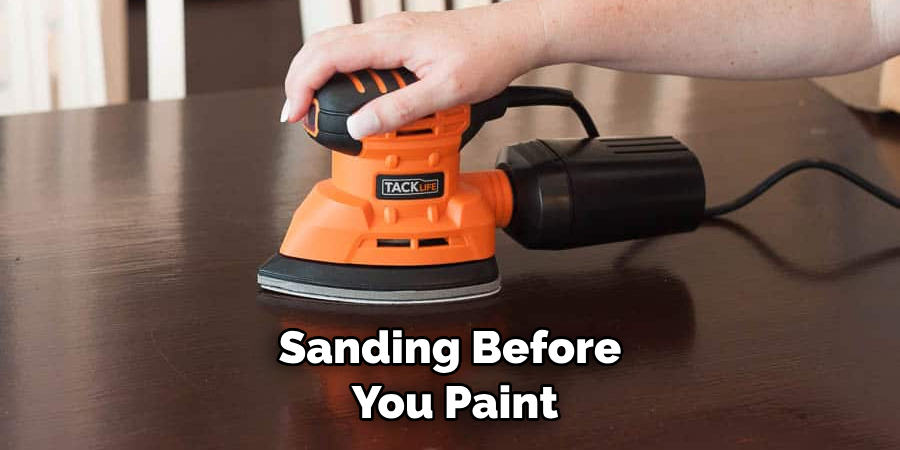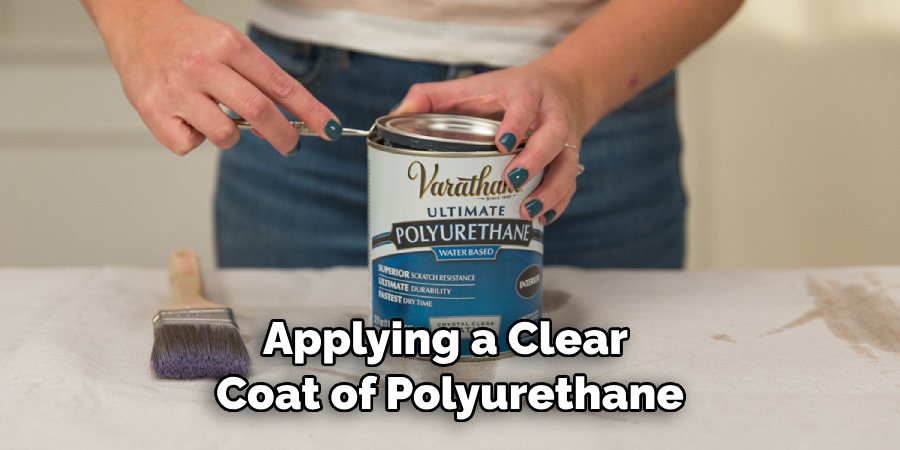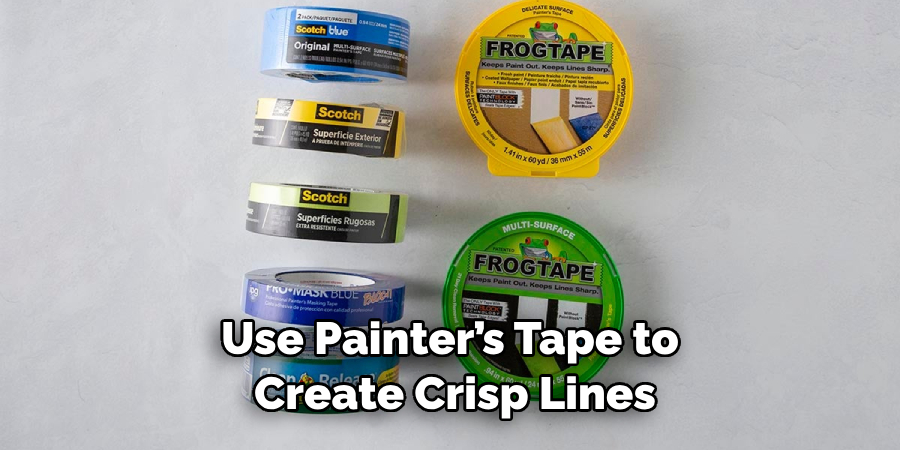Do you have a desk in desperate need of a makeover but hesitant to sand? If so – you’ll be relieved to know that paint can give your old furniture just the refresh it craves without all the hassle of power tools.

Paint can be a great way to give an old desk new life! Whether your desk is outdated, has seen better days, or just needs a little sprucing up, painting it without sanding can create a fresh and vibrant look that adds character to any space.
With the right materials and preparation, you can restructure any outdated piece into a stylish work of art that will take pride of place in your home.
Whether you’re spraying or working with a brush, if you want your While creating an updated look for your favorite furniture may seem like a daunting task; we’ll help make this project easy and achievable with these step-by-step guidelines on how to paint a desk without sanding! Keep reading for our best tips on how to paint furniture without having to make things dusty by sanding first!
The Necessity of Sanding
1. Effective Painting
Before we get into the details of how to paint a desk without sanding, let’s go over why sanding is often necessary when painting furniture. By sanding down the wood before you paint it, you create small abrasions in the surface that will allow the primer and paint to adhere more effectively. This process removes any old varnish or wax that may be present on a desk’s surface and ensures the furniture is ready for painting.
2. Smoother Finish
The second benefit of sanding before you paint is that it creates a smoother finish on the wood. Sanding helps to create an even coat so that your painted piece looks polished when completed. Without sanding, the paint can appear blotchy or uneven in some areas.
Can You Get the Same Result Without Sanding?

The answer is yes! While sanding furniture before painting helps to ensure that the primer and paint adhere more effectively, you don’t have to sand a desk in order to achieve an attractive finish. With some extra preparation and materials, painting without sanding can still give your piece a smooth and polished look.
Choosing the Best Painting for Your Desk
The type of paint you choose for your desk is just as important as the process you use to apply it. Before you begin painting, decide which kind of finish will best suit your piece.
While both oil-based and water-based paints can be used without sanding beforehand – oil-based paints have a smoother finish and tend to adhere better than water-based paints. If you’re looking to achieve a glossy finish, an oil-based paint is the way to go!
Preparing for Painting Without Sanding
1. Clean the Area
The first step to preparing a desk for painting without sanding is to make sure that the surface is clean and free of any dirt, dust, or grease. Use a damp cloth to wipe down surfaces and remove any debris. This will help ensure that the paint adheres properly when applied.
2. Start with a Clean Slate
Next, you want to remove any existing paint or stain from the desk’s surface. You can do this using a liquid stripper or sanding block. Make sure to wear protective gloves when using these materials and follow the manufacturer’s instructions for safety.
3. Prime the Desk
Once your desk is clean and free of any existing coats of paint or stain, you should apply a primer that is designed to help the paint adhere. Make sure to choose a primer that is oil-based for best results.

How to Paint a Desk Without Sanding in 6 Steps
Step 1: Prep Your Furniture
Although sanding is not necessary for this project, you will still need to adequately prep your desk before painting. Clean the surface with an all-purpose cleaner and then use a damp cloth to remove any residual dirt or dust. Once dry, apply a coat of oil-based primer and allow it to dry (usually around 2 hours).
Step 2: Choose Your Paint
When it comes to painting without sanding, you will want to choose a high-quality paint that is designed specifically for furniture. Oil-based paints are the most popular choice as they provide superior coverage and durability.
Step 3: Apply the Paint
Once you’ve chosen your paint, it’s time to start painting! When applying the paint, make sure to use long strokes and even pressure for a smooth finish. Start in one corner of the desk and work your way outwards. You may need to do two coats depending on the depth of color you want.
Step 4: Allow to Dry
Allow your deck to dry for at least 24 hours before applying any additional coats of paint. You may also want to let it sit for a few days after the final coat so that it is completely dry.
Step 5: Seal the Paint

Once the paint is completely dry, it’s time to seal it. This will ensure that your desk looks great for years to come! Use a furniture wax or polyurethane to seal the paint and protect it from scratches and damage.
Step 6: Enjoy Your New Desk
Congratulations! After all of this hard work, you have a brand new desk that is ready to be enjoyed. Feel free to add any decorative touches, such as hardware, knobs, or handles, to personalize it and make it truly yours!
Painting a desk without sanding can be a great way to give an old piece of furniture a fresh look. With the right materials and preparation, you can give your desk a beautiful update without the hassle of sanding. Follow these steps to learn how to paint a desk without sanding and create your very own masterpiece!
8 Maintenance Tips
For best results with your desk painting project, here are some maintenance tips to follow:
- Always clean with a damp cloth or soap and water before painting. A clean surface will help the paint adhere better. Otherwise, it will scratch off easily.
- When spraying the paint on, don’t hold the can too close to the surface, or you could end up with an uneven coat. Keep the nozzle moving and at least 12 inches away from your desk for best results.
- Don’t rush the project – allow plenty of time for the paint to dry and cure after each coat.
- If you’re using multiple colors, be sure to apply a base coat of white or grey before adding other colors on top. This will help you get better coverage and a more vibrant color.
- Use an oil-based paint for best results. Latex paints can be used, but they tend to chip and scratch easily.
- To prevent chipping and scratches in the future, consider applying a clear coat of polyurethane when you’re finished painting.
- If you want an antique look, use sandpaper or steel wool to give the desk a distressed look.
- Finally, make sure your workspace is well-ventilated and have plenty of newspapers or drop cloths to protect your surfaces from paint splatters.

By following these tips, you can create a beautiful, long-lasting finish on your desk without having to sand it first!
6 Safety Measures to Take Before Painting a Desk Without Sanding
Painting a desk without sanding can be intimidating, especially if you have never done it before. However, by following the proper safety measures, you can successfully paint your desk and have it look like new in no time! Here are 6 essential safety tips to consider when painting your desk without sanding:
- Wear the right gear. Make sure to wear protective clothing such as goggles, respirator masks, and gloves when painting your desk. This will help protect you from any harmful fumes or splatters of paint that may occur during the process.
- Prepare your workspace. Clear off any items that are not necessary for painting your desk and ensure the area is well-ventilated before beginning.
- Clean the desk surface. Dust and dirt can get in the way of a smooth paint job, so make sure to thoroughly clean your desk surface before starting.
- Use a primer. Applying a primer helps create an even coat of paint for your desk without sanding it down beforehand. Primer also helps protect the wood from any water damage.
- Use a brush or roller for an even finish. If you opt to use a brush, make sure the bristles are soft and not too stiff, as this can cause streaks in your paint job.
- Let the primer dry completely before painting. It’s important to let the primer dry for at least 24 hours before applying any paint so that the paint can properly adhere to the desk.
By following these 6 safety measures on how to paint a desk without sanding, you can confidently paint your desk sanding and give it a brand new look. Good luck!
Additional Tips for Painting Your Desk Without Sanding
Once you have completed the 6 essential safety steps outlined above, there are some additional tips to consider that can help you get the best result with your desk painting project.
- For a smoother finish, sand lightly between coats of paint. It will always be tempting to skip this step, but it can make a big difference in the quality of your finished product.
- Use painter’s tape to create crisp lines and edges around any fixtures or hardware on your desk. This will help keep them clean and give you a more polished look once the paint is dry.
- To prevent bubbling or cracking, use a paint that is made specifically for furniture. This type of paint will be more durable and resistant to scratches so that your desk can look new for years to come.

By taking the time to prepare correctly and following these additional tips on how to paint a desk without sanding, you will have a beautiful, new-looking desk in no time! Enjoy your new project!
Conclusion
Painting a desk without sanding is not only a great way to add style and class to any home or office but it also can be completed in less time and with fewer materials while still yielding a high-quality, long lasting result.
Not only will the newly painted desk look amazing, but it will protect your desk for years to come. With proper preparation and knowledge of the best materials to use, you can create a truly unique look that is sure to catch the eye of everyone who enters the room.
Whether you’re painting for style or protection, rest assured that this creative project will last for many years if done correctly. Taking into consideration all of these factors on how to paint a desk without sanding, there are no reasons why you shouldn’t consider revamping your old desk with a quick paint job! So forget about sanding and pick up your brush — you’re one step closer to having a great new asset in your home.

